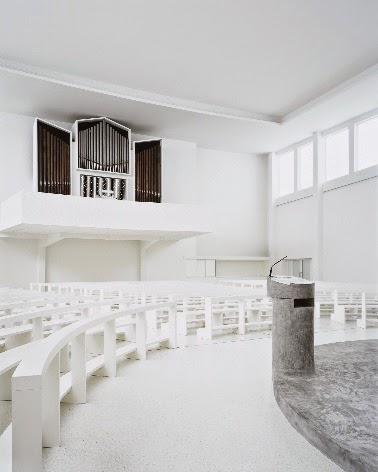In our church, which is a Lutheran
parish church, we distribute the bread and wine in two different
ways: by the altar or in a line, dipping the wafer in the wine.
The traditional way is to come up the
the altar ring and kneel. We have our small shiny cups in hand, and
the priest and a minister walk softly on the inside of the ring,
quietly distributing the elements to each one, with the words: This
is the body of Christ. This is the blood of Christ.
We kneel shoulder to shoulder. I feel
the warmth of my brother and my sister.
 |
| Altertavle, Kviteseid kyrkje |
Sometimes the time is at a standstill.
The wooden carving of the Lamb with a pennant of victory on the altar
piece shows me the risen Lord Jesus. He is mild and mighty. He is
righteousness and kindness. It is not the image, the wooden image
that comforts me; it is the reality it points to. It is the risen
Christ.
 |
| Kviteseid kyrkje |
The light comes brightly from the
left, broken in a prism of soft colours by the stained glass. It
plays on the carpet, on the vestments of the moving priest. Anyone
would know that the light is from the big star in the sky, but in my
seconds of eternal time, I relish the moment of heavenly light: for
truth is in its beams. There is no chance of hiding anything when
kneeling before the King of Heaven. He sees the innermost part of my
soul, my thoughts, my feelings. He knows, and I know that he knows;
and in his light i confess my sin and shortcomings, and in his light
I am cleansed. Forgiven. Renewed.
I eagerly wait for the the comforting
word of assurance from the priest, as he dismisses me and the others,
to make room for yet another set of brothers and sisters, kneeling to
receive the same Lord, the same forgiveness, and rise renewed.
There is singing, the organ blows its
mighty pipes, and there is the sweet quiet when the organist receives
his portion.
There is communion - with God, with
each other, and, in a diffuse way, with the ones who have gone before
us - who are free to kneel at the other half of the altar ring, the
one that is invisible to us. We have no direct contact with them, but
we cherish their memory, and they may remind us of the hope we have.
They are with God, and one day we will meet again... my dad and I.























